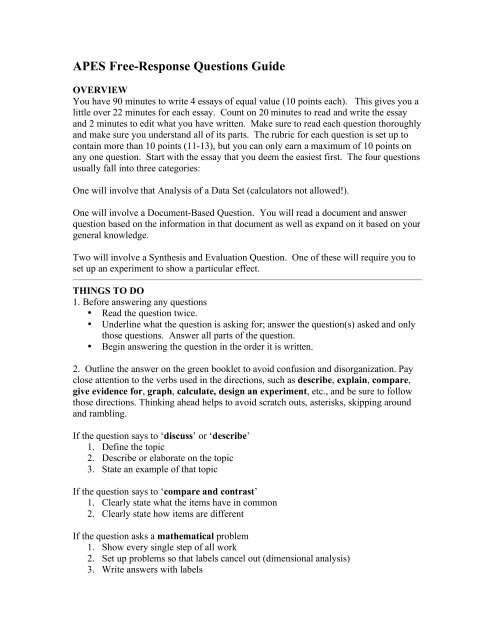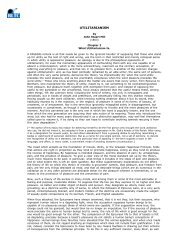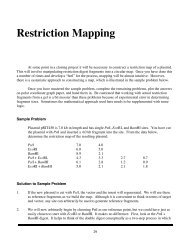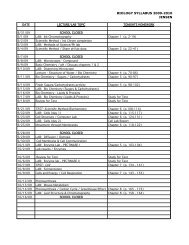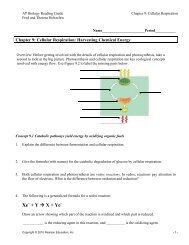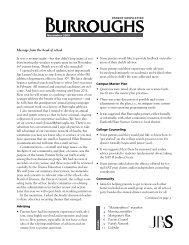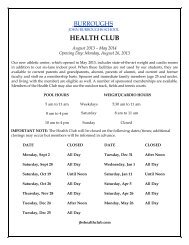APES Free-Response Questions Guide
APES Free-Response Questions Guide
APES Free-Response Questions Guide
- No tags were found...
You also want an ePaper? Increase the reach of your titles
YUMPU automatically turns print PDFs into web optimized ePapers that Google loves.
<strong>APES</strong> <strong>Free</strong>-<strong>Response</strong> <strong>Questions</strong> <strong>Guide</strong>OVERVIEWYou have 90 minutes to write 4 essays of equal value (10 points each). This gives you alittle over 22 minutes for each essay. Count on 20 minutes to read and write the essayand 2 minutes to edit what you have written. Make sure to read each question thoroughlyand make sure you understand all of its parts. The rubric for each question is set up tocontain more than 10 points (11-13), but you can only earn a maximum of 10 points onany one question. Start with the essay that you deem the easiest first. The four questionsusually fall into three categories:One will involve that Analysis of a Data Set (calculators not allowed!).One will involve a Document-Based Question. You will read a document and answerquestion based on the information in that document as well as expand on it based on yourgeneral knowledge.Two will involve a Synthesis and Evaluation Question. One of these will require you toset up an experiment to show a particular effect.THINGS TO DO1. Before answering any questions• Read the question twice.• Underline what the question is asking for; answer the question(s) asked and onlythose questions. Answer all parts of the question.• Begin answering the question in the order it is written.2. Outline the answer on the green booklet to avoid confusion and disorganization. Payclose attention to the verbs used in the directions, such as describe, explain, compare,give evidence for, graph, calculate, design an experiment, etc., and be sure to followthose directions. Thinking ahead helps to avoid scratch outs, asterisks, skipping aroundand rambling.If the question says to ‘discuss’ or ‘describe’1. Define the topic2. Describe or elaborate on the topic3. State an example of that topicIf the question says to ‘compare and contrast’1. Clearly state what the items have in common2. Clearly state how items are differentIf the question asks a mathematical problem1. Show every single step of all work2. Set up problems so that labels cancel out (dimensional analysis)3. Write answers with labels
8. Go into detail that is on the subject and to the point. Be sure to include the obvious (forexample, "light is necessary for photosynthesis"). Answer the question thoroughly.9. If you cannot remember a word exactly, take a shot at it - get as close as you can. Evenif you don't remember the name of the concept, describe the concept.10. Remember that no detail is too small to be included as long as it is to the point. Besure to include the obvious - most points are given for the basics anyway.11. Carefully label your diagrams (otherwise they get no points). Place them in the text atthe appropriate place, not attached at the end.12. Widen your margins a little. This will make the essay easier for most folks to read.13. Bring a watch to the exam so you can pace yourself. You have four essays to answerwith about 22 minutes for each.14. Understand that the exam is written to be hard. The national average for the essaysection will be about 50% correct (i.e., 5/10). It is very likely that you will not knoweverything. This is expected, but it is very likely that you do know something about eachessay, so relax and do the best you can. Write thorough answers.15. The AP Exam may include what are called synthesis and conceptual questions. Thesequestions may ask you to indicate the relationship between two or more concepts. If youdo not know the relationship between the concepts, at least tell what you do know aboutthem individually.THINGS NOT TO DO1. Do not waste time on background information or a long introduction unless thequestions call for historical development or historical significance. Answer the question.2. Don't ramble. Get top the point; don't shoot the bull. Say what you know and go on tothe next question. You can always come back later and add information if you remembersomething.3. Don't use felt tip pens -they leak through the paper and make both sides hard to read.Do not obliterate information you want to delete. One or two lines drawn through theword(s) should be sufficient. Don't write more than a very few words in the margin. Don'twrite sloppily. It is easier for the grader to miss an important word when he/she cannotread your handwriting.4. Don't panic or get angry because you are unfamiliar with the question. You probablyhave read or heard something about the subject - be calm and think.5. Don't worry about spelling every word perfectly or using exact grammar. These are not
a part of the standards the graders use. It is important for you to know, however, that verypoor spelling and grammar will hurt your chances.6. There is no need to say the same thing twice. While introductory paragraphs may beimportant in English class, saying, "Process A is controlled by x, y, and z" and thenwriting a paragraph each on A, X, y, and z is a waste of valuable time. This also goes forrestating the question. Don't restate the question, just answer it.7. If given a choice of two or three topics to write about, understand that only the firstone(s) you write about will count. You must make a choice and stick with it. If youdecide that your first choice was a bad one, then cross out that part of the answer so thereader knows clearly which part you wish to be considered for credit. If the question saysto choose 3 out of 5 topics, choose the 3 you are the most confident of, in other words,”the “best” answers you can provide. If the question asks specifically about RNA, don’tdiscuss DNA duplication.8. Don't leave questions blank. Remember that each point you earn on an essay questionis the equivalent of two correct multiple-choice questions, and there is no penalty for awrong guess, bad spelling or bad grammar. Make an effort on every question!9. Avoid using vague terminology. Examples are the following terms/phrases that needsome specific descriptive information: pollution, factory, contamination, runoff, killsstuff, smokestacks, bad, toxic, harmful, bad for the environment, negatively influences,energy source, waste, chemicals, pesticides, good/bad, better/worse. You must do morethan “term drop” – show that you actually understand the specifics.10. Do not include opinion, points of view or flippant answers.11. Don't Quit!FINAL THOUGHTSGet to the pointBe concise. Be precise.Don't waste time adding any additional information. Credit is only given for informationrequested.Give examples whenever you can, but still be concise.Don’t list items in an outline form. Use normal sentence structure to give a list of items.Always use complete sentences and good penmanship. If they can't read it, they can'tgrade it.For questions involving calculations, calculators are not allowed. You can get credit forsetting up a problem correctly and showing all work including correct units. You receiveno credit for the correct answer only.


